A Comprehensive Research Report: Ageism Discrimination in Workplace
VerifiedAdded on 2023/06/05
|18
|4664
|434
Report
AI Summary
This research report delves into the issue of ageism in the workplace, aiming to understand its conceptual basis, its role in fostering discrimination, and strategies for its eradication. The literature review examines existing research on age discrimination, including its impact on employees and potential legal ramifications, while also identifying gaps in current understanding. The research methodology employs a deductive approach, utilizing quantitative methods and a mixed-data collection strategy to gather both statistical and non-statistical data. A survey questionnaire and literature review are used as research strategies to collect relevant data, with descriptive research methods applied to identify the characteristics of ageism discrimination. Ethical considerations are addressed, and potential research limitations are acknowledged, providing a comprehensive overview of the research design and its potential value in addressing ageism in the workplace. Desklib offers a wealth of similar reports and solved assignments for students.
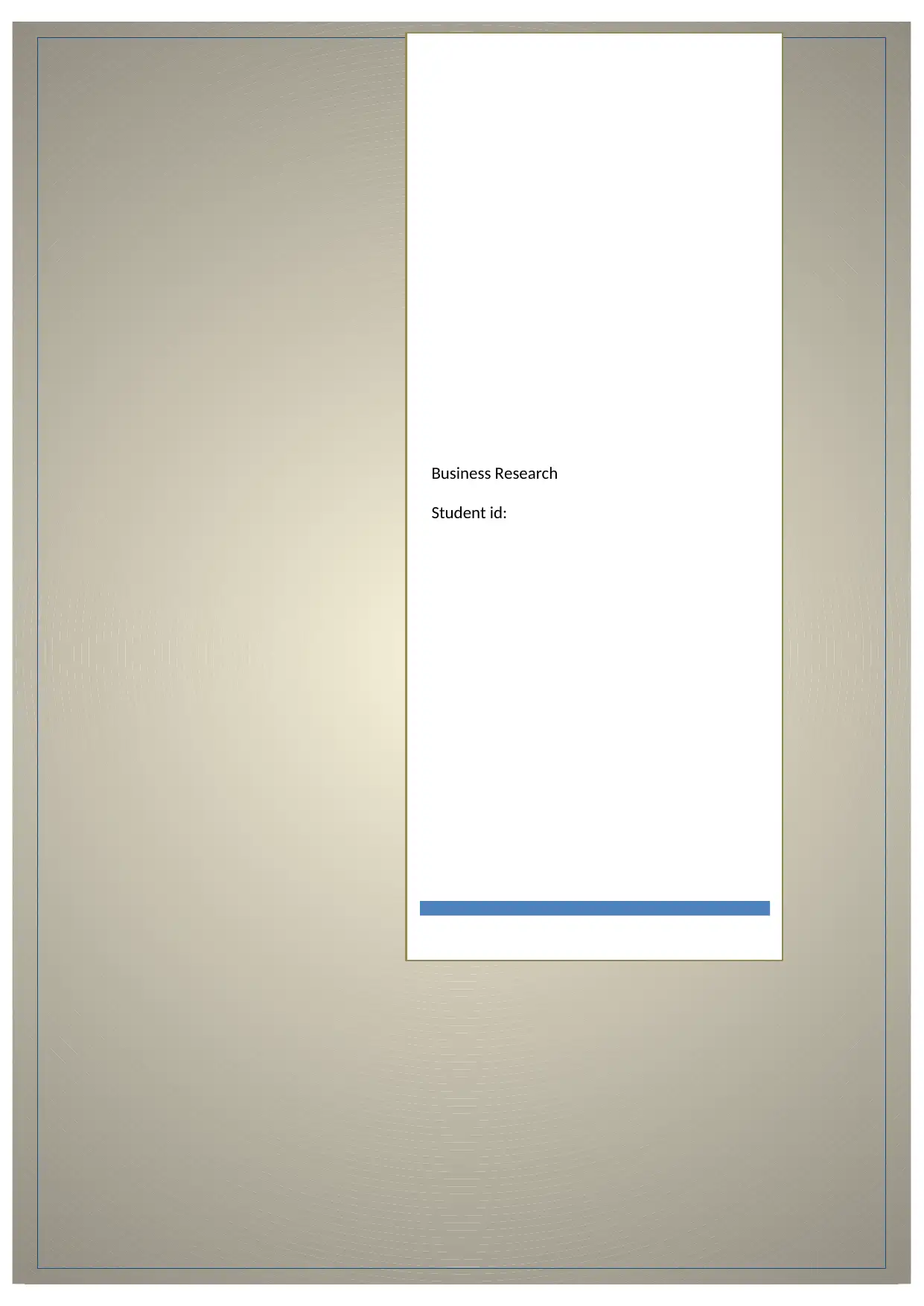
Business Research
Student id:
Student id:
Paraphrase This Document
Need a fresh take? Get an instant paraphrase of this document with our AI Paraphraser

Table of Contents
Introduction................................................................................................................................2
Research Objectives...............................................................................................................2
Literature review........................................................................................................................2
RO1: To discover the conceptual understanding about the ageism in the working place......2
RO2: To discover the role of ageism in creating discrimination at the working place..........3
RO3: To recommend strategies for removing the ageism discrimination from working
place........................................................................................................................................3
Literature gap..........................................................................................................................4
Research questions.....................................................................................................................4
Research hypothesis...................................................................................................................4
Introduction............................................................................................................................4
Research philosophy...............................................................................................................5
Research approach..................................................................................................................6
Research types........................................................................................................................7
Research Strategy...................................................................................................................7
Research Purpose....................................................................................................................8
Data collection method...........................................................................................................9
Sampling method....................................................................................................................9
Data analysis method............................................................................................................11
Ethical consideration............................................................................................................11
Potential strength and Research limitation...........................................................................12
Value of research..................................................................................................................12
Summary...............................................................................................................................13
Gantt chart................................................................................................................................13
References................................................................................................................................15
Introduction................................................................................................................................2
Research Objectives...............................................................................................................2
Literature review........................................................................................................................2
RO1: To discover the conceptual understanding about the ageism in the working place......2
RO2: To discover the role of ageism in creating discrimination at the working place..........3
RO3: To recommend strategies for removing the ageism discrimination from working
place........................................................................................................................................3
Literature gap..........................................................................................................................4
Research questions.....................................................................................................................4
Research hypothesis...................................................................................................................4
Introduction............................................................................................................................4
Research philosophy...............................................................................................................5
Research approach..................................................................................................................6
Research types........................................................................................................................7
Research Strategy...................................................................................................................7
Research Purpose....................................................................................................................8
Data collection method...........................................................................................................9
Sampling method....................................................................................................................9
Data analysis method............................................................................................................11
Ethical consideration............................................................................................................11
Potential strength and Research limitation...........................................................................12
Value of research..................................................................................................................12
Summary...............................................................................................................................13
Gantt chart................................................................................................................................13
References................................................................................................................................15

Introduction
Research Objectives
The aim of this research is to discover an individual’s own understanding and awareness of
the presence of ageism in society and its influence on work-related decisions. The following
objectives will be used by the researcher to accomplish the specified aim of this research:
To discover the conceptual understanding about the ageism in the working place
To discover the role of ageism in creating discrimination at the working place
To recommend strategies for removing the ageism discrimination from working place
Literature review
RO1: To discover the conceptual understanding about the ageism in the working place
According to Okechukwu et al. (2014), age discrimination within an organization is the
practices of authorizing the age of person unfairly. It may become a key factor while focusing
on the new job, other job benefits, and promotion. The company makes a decision regarding
terminating workforces who cannot be exclusively based on their age. Moreover, age-
discrimination could impact older employees who feel they have been discriminated against
in favor of young employees.
In contrast to this, Macdonald and Levy (2016) evaluated that there have been cases entailing
younger employees being displaced by older employees. The age discrimination in
employment act of 1967 makes it unlawful for a corporation with 20 or more workforces to
create employment decision such as benefits, pay, person’s age, and promotions. The
employer should emphasize on employee talent and skills. The ADEA includes workforces of
40 or more years of age.
RO2: To discover the role of ageism in creating discrimination at the working place
As per the view of Bayl‐Smith and Griffin (2014) age discrimination can have a negative
impact on the working atmosphere of business. Age discrimination not only can damage the
Research Objectives
The aim of this research is to discover an individual’s own understanding and awareness of
the presence of ageism in society and its influence on work-related decisions. The following
objectives will be used by the researcher to accomplish the specified aim of this research:
To discover the conceptual understanding about the ageism in the working place
To discover the role of ageism in creating discrimination at the working place
To recommend strategies for removing the ageism discrimination from working place
Literature review
RO1: To discover the conceptual understanding about the ageism in the working place
According to Okechukwu et al. (2014), age discrimination within an organization is the
practices of authorizing the age of person unfairly. It may become a key factor while focusing
on the new job, other job benefits, and promotion. The company makes a decision regarding
terminating workforces who cannot be exclusively based on their age. Moreover, age-
discrimination could impact older employees who feel they have been discriminated against
in favor of young employees.
In contrast to this, Macdonald and Levy (2016) evaluated that there have been cases entailing
younger employees being displaced by older employees. The age discrimination in
employment act of 1967 makes it unlawful for a corporation with 20 or more workforces to
create employment decision such as benefits, pay, person’s age, and promotions. The
employer should emphasize on employee talent and skills. The ADEA includes workforces of
40 or more years of age.
RO2: To discover the role of ageism in creating discrimination at the working place
As per the view of Bayl‐Smith and Griffin (2014) age discrimination can have a negative
impact on the working atmosphere of business. Age discrimination not only can damage the
⊘ This is a preview!⊘
Do you want full access?
Subscribe today to unlock all pages.

Trusted by 1+ million students worldwide
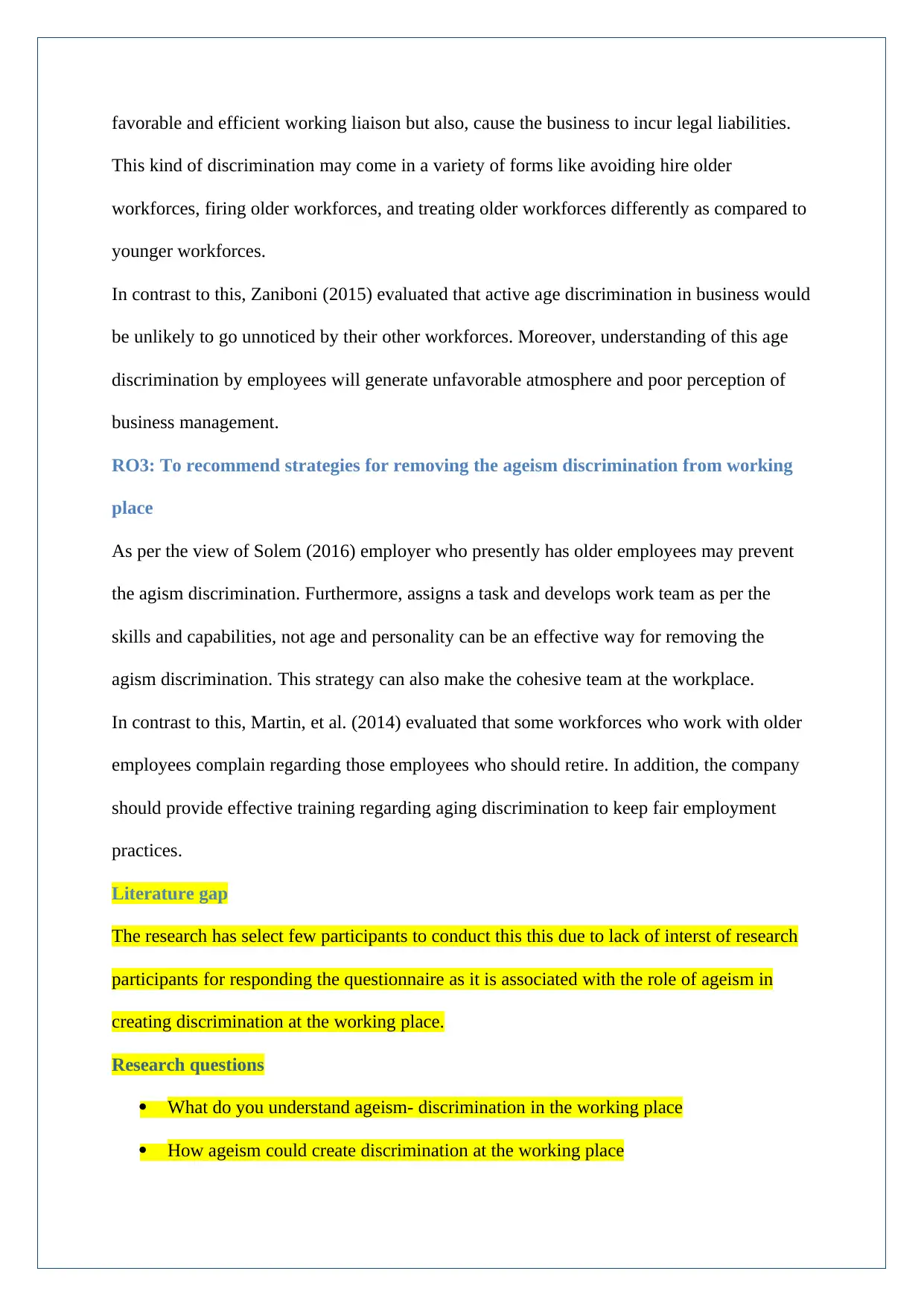
favorable and efficient working liaison but also, cause the business to incur legal liabilities.
This kind of discrimination may come in a variety of forms like avoiding hire older
workforces, firing older workforces, and treating older workforces differently as compared to
younger workforces.
In contrast to this, Zaniboni (2015) evaluated that active age discrimination in business would
be unlikely to go unnoticed by their other workforces. Moreover, understanding of this age
discrimination by employees will generate unfavorable atmosphere and poor perception of
business management.
RO3: To recommend strategies for removing the ageism discrimination from working
place
As per the view of Solem (2016) employer who presently has older employees may prevent
the agism discrimination. Furthermore, assigns a task and develops work team as per the
skills and capabilities, not age and personality can be an effective way for removing the
agism discrimination. This strategy can also make the cohesive team at the workplace.
In contrast to this, Martin, et al. (2014) evaluated that some workforces who work with older
employees complain regarding those employees who should retire. In addition, the company
should provide effective training regarding aging discrimination to keep fair employment
practices.
Literature gap
The research has select few participants to conduct this this due to lack of interst of research
participants for responding the questionnaire as it is associated with the role of ageism in
creating discrimination at the working place.
Research questions
What do you understand ageism- discrimination in the working place
How ageism could create discrimination at the working place
This kind of discrimination may come in a variety of forms like avoiding hire older
workforces, firing older workforces, and treating older workforces differently as compared to
younger workforces.
In contrast to this, Zaniboni (2015) evaluated that active age discrimination in business would
be unlikely to go unnoticed by their other workforces. Moreover, understanding of this age
discrimination by employees will generate unfavorable atmosphere and poor perception of
business management.
RO3: To recommend strategies for removing the ageism discrimination from working
place
As per the view of Solem (2016) employer who presently has older employees may prevent
the agism discrimination. Furthermore, assigns a task and develops work team as per the
skills and capabilities, not age and personality can be an effective way for removing the
agism discrimination. This strategy can also make the cohesive team at the workplace.
In contrast to this, Martin, et al. (2014) evaluated that some workforces who work with older
employees complain regarding those employees who should retire. In addition, the company
should provide effective training regarding aging discrimination to keep fair employment
practices.
Literature gap
The research has select few participants to conduct this this due to lack of interst of research
participants for responding the questionnaire as it is associated with the role of ageism in
creating discrimination at the working place.
Research questions
What do you understand ageism- discrimination in the working place
How ageism could create discrimination at the working place
Paraphrase This Document
Need a fresh take? Get an instant paraphrase of this document with our AI Paraphraser
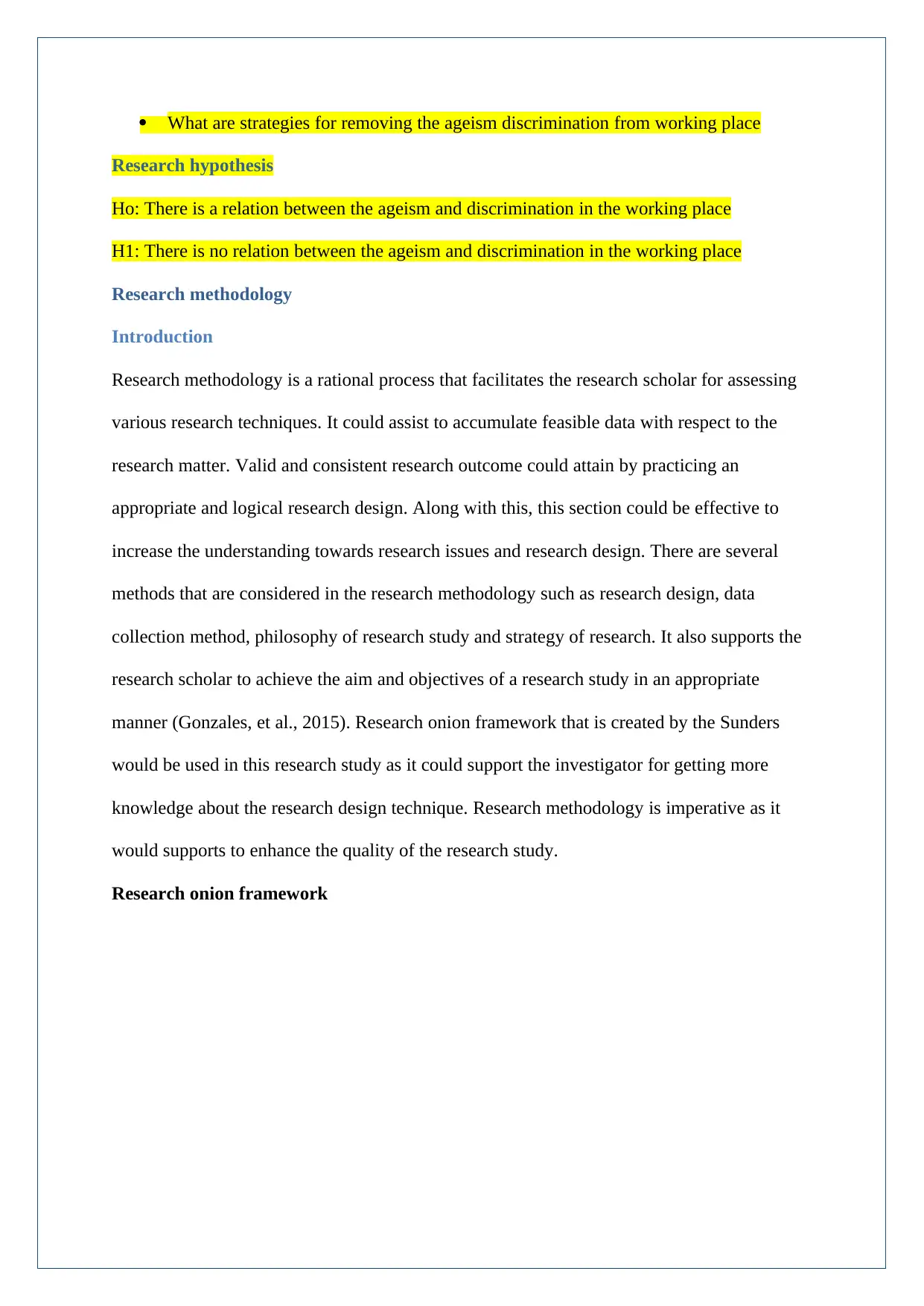
What are strategies for removing the ageism discrimination from working place
Research hypothesis
Ho: There is a relation between the ageism and discrimination in the working place
H1: There is no relation between the ageism and discrimination in the working place
Research methodology
Introduction
Research methodology is a rational process that facilitates the research scholar for assessing
various research techniques. It could assist to accumulate feasible data with respect to the
research matter. Valid and consistent research outcome could attain by practicing an
appropriate and logical research design. Along with this, this section could be effective to
increase the understanding towards research issues and research design. There are several
methods that are considered in the research methodology such as research design, data
collection method, philosophy of research study and strategy of research. It also supports the
research scholar to achieve the aim and objectives of a research study in an appropriate
manner (Gonzales, et al., 2015). Research onion framework that is created by the Sunders
would be used in this research study as it could support the investigator for getting more
knowledge about the research design technique. Research methodology is imperative as it
would supports to enhance the quality of the research study.
Research onion framework
Research hypothesis
Ho: There is a relation between the ageism and discrimination in the working place
H1: There is no relation between the ageism and discrimination in the working place
Research methodology
Introduction
Research methodology is a rational process that facilitates the research scholar for assessing
various research techniques. It could assist to accumulate feasible data with respect to the
research matter. Valid and consistent research outcome could attain by practicing an
appropriate and logical research design. Along with this, this section could be effective to
increase the understanding towards research issues and research design. There are several
methods that are considered in the research methodology such as research design, data
collection method, philosophy of research study and strategy of research. It also supports the
research scholar to achieve the aim and objectives of a research study in an appropriate
manner (Gonzales, et al., 2015). Research onion framework that is created by the Sunders
would be used in this research study as it could support the investigator for getting more
knowledge about the research design technique. Research methodology is imperative as it
would supports to enhance the quality of the research study.
Research onion framework

For achieving the aim and objectives of the research study, the research onion framework
could be important as it delivers depth knowledge towards many imperative tools. Current
research could be accomplished with the help of the research onion framework in the
following way:
Research philosophy
In the research study, the research philosophy approach relies on the understanding and
observation of the investigator, which could assist to get depth knowledge about research
concern. Apart from this, it is a process of thinking to develop depth knowledge regarding
research matter. There are various types of research philosophies, which are utilized by the
research scholar to accomplish the investigation in an appropriate manner such as realism,
interpretivism, and positivism. Interpretivism philosophy based on trust and perception of
human (O'loughlin, et al., 2017). It could be prominent to gain the brief understanding about
the research dilemma and it would allow the research scholar to act as an interpreter. The
positivism philosophy could be relied on figures, valid evidence and facts. It could be
significant for statistical research. The realism philosophy created by using a combination of
both philosophy approaches named interpretivism and positivism (Davey, 2014).
could be important as it delivers depth knowledge towards many imperative tools. Current
research could be accomplished with the help of the research onion framework in the
following way:
Research philosophy
In the research study, the research philosophy approach relies on the understanding and
observation of the investigator, which could assist to get depth knowledge about research
concern. Apart from this, it is a process of thinking to develop depth knowledge regarding
research matter. There are various types of research philosophies, which are utilized by the
research scholar to accomplish the investigation in an appropriate manner such as realism,
interpretivism, and positivism. Interpretivism philosophy based on trust and perception of
human (O'loughlin, et al., 2017). It could be prominent to gain the brief understanding about
the research dilemma and it would allow the research scholar to act as an interpreter. The
positivism philosophy could be relied on figures, valid evidence and facts. It could be
significant for statistical research. The realism philosophy created by using a combination of
both philosophy approaches named interpretivism and positivism (Davey, 2014).
⊘ This is a preview!⊘
Do you want full access?
Subscribe today to unlock all pages.

Trusted by 1+ million students worldwide
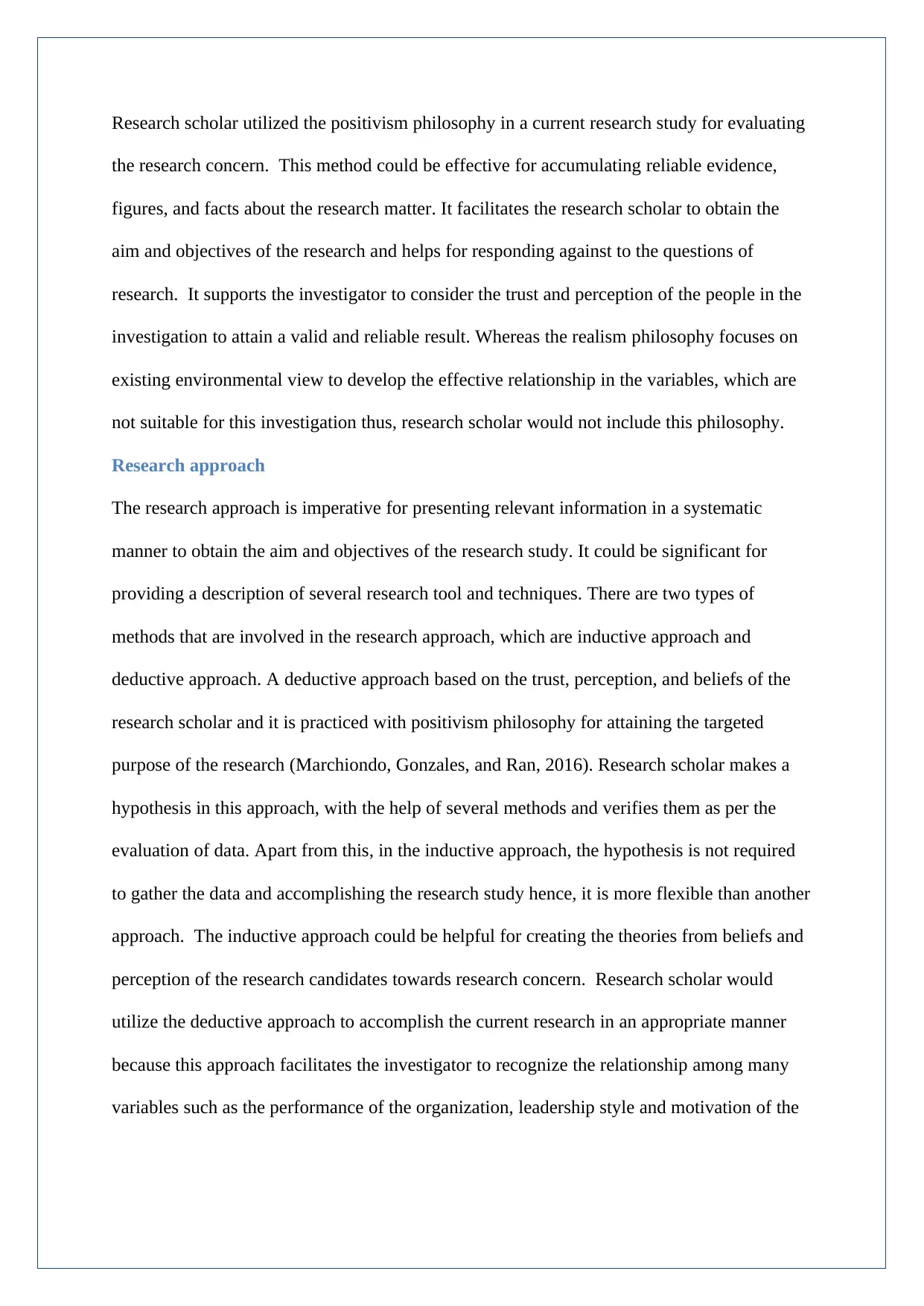
Research scholar utilized the positivism philosophy in a current research study for evaluating
the research concern. This method could be effective for accumulating reliable evidence,
figures, and facts about the research matter. It facilitates the research scholar to obtain the
aim and objectives of the research and helps for responding against to the questions of
research. It supports the investigator to consider the trust and perception of the people in the
investigation to attain a valid and reliable result. Whereas the realism philosophy focuses on
existing environmental view to develop the effective relationship in the variables, which are
not suitable for this investigation thus, research scholar would not include this philosophy.
Research approach
The research approach is imperative for presenting relevant information in a systematic
manner to obtain the aim and objectives of the research study. It could be significant for
providing a description of several research tool and techniques. There are two types of
methods that are involved in the research approach, which are inductive approach and
deductive approach. A deductive approach based on the trust, perception, and beliefs of the
research scholar and it is practiced with positivism philosophy for attaining the targeted
purpose of the research (Marchiondo, Gonzales, and Ran, 2016). Research scholar makes a
hypothesis in this approach, with the help of several methods and verifies them as per the
evaluation of data. Apart from this, in the inductive approach, the hypothesis is not required
to gather the data and accomplishing the research study hence, it is more flexible than another
approach. The inductive approach could be helpful for creating the theories from beliefs and
perception of the research candidates towards research concern. Research scholar would
utilize the deductive approach to accomplish the current research in an appropriate manner
because this approach facilitates the investigator to recognize the relationship among many
variables such as the performance of the organization, leadership style and motivation of the
the research concern. This method could be effective for accumulating reliable evidence,
figures, and facts about the research matter. It facilitates the research scholar to obtain the
aim and objectives of the research and helps for responding against to the questions of
research. It supports the investigator to consider the trust and perception of the people in the
investigation to attain a valid and reliable result. Whereas the realism philosophy focuses on
existing environmental view to develop the effective relationship in the variables, which are
not suitable for this investigation thus, research scholar would not include this philosophy.
Research approach
The research approach is imperative for presenting relevant information in a systematic
manner to obtain the aim and objectives of the research study. It could be significant for
providing a description of several research tool and techniques. There are two types of
methods that are involved in the research approach, which are inductive approach and
deductive approach. A deductive approach based on the trust, perception, and beliefs of the
research scholar and it is practiced with positivism philosophy for attaining the targeted
purpose of the research (Marchiondo, Gonzales, and Ran, 2016). Research scholar makes a
hypothesis in this approach, with the help of several methods and verifies them as per the
evaluation of data. Apart from this, in the inductive approach, the hypothesis is not required
to gather the data and accomplishing the research study hence, it is more flexible than another
approach. The inductive approach could be helpful for creating the theories from beliefs and
perception of the research candidates towards research concern. Research scholar would
utilize the deductive approach to accomplish the current research in an appropriate manner
because this approach facilitates the investigator to recognize the relationship among many
variables such as the performance of the organization, leadership style and motivation of the
Paraphrase This Document
Need a fresh take? Get an instant paraphrase of this document with our AI Paraphraser
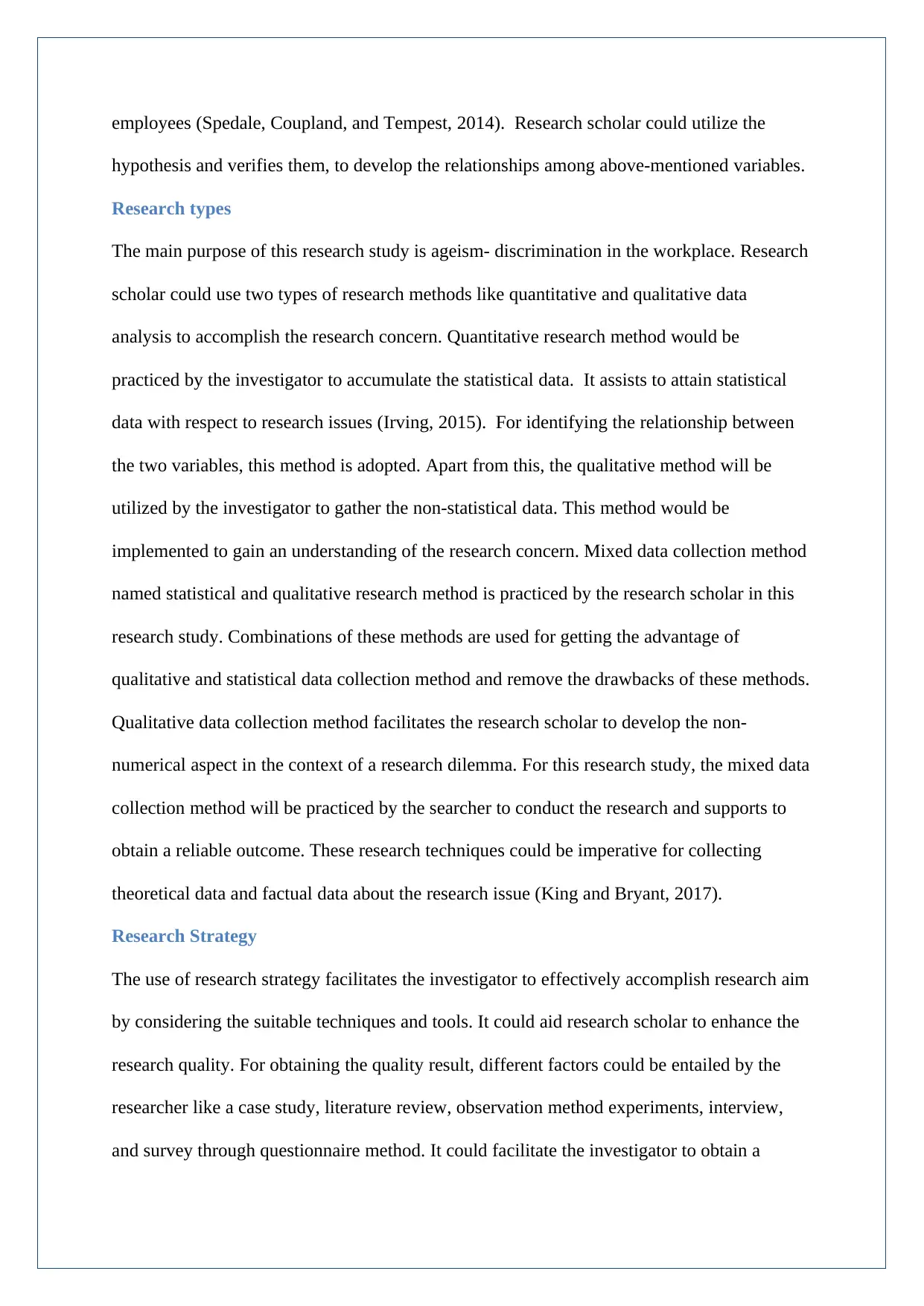
employees (Spedale, Coupland, and Tempest, 2014). Research scholar could utilize the
hypothesis and verifies them, to develop the relationships among above-mentioned variables.
Research types
The main purpose of this research study is ageism- discrimination in the workplace. Research
scholar could use two types of research methods like quantitative and qualitative data
analysis to accomplish the research concern. Quantitative research method would be
practiced by the investigator to accumulate the statistical data. It assists to attain statistical
data with respect to research issues (Irving, 2015). For identifying the relationship between
the two variables, this method is adopted. Apart from this, the qualitative method will be
utilized by the investigator to gather the non-statistical data. This method would be
implemented to gain an understanding of the research concern. Mixed data collection method
named statistical and qualitative research method is practiced by the research scholar in this
research study. Combinations of these methods are used for getting the advantage of
qualitative and statistical data collection method and remove the drawbacks of these methods.
Qualitative data collection method facilitates the research scholar to develop the non-
numerical aspect in the context of a research dilemma. For this research study, the mixed data
collection method will be practiced by the searcher to conduct the research and supports to
obtain a reliable outcome. These research techniques could be imperative for collecting
theoretical data and factual data about the research issue (King and Bryant, 2017).
Research Strategy
The use of research strategy facilitates the investigator to effectively accomplish research aim
by considering the suitable techniques and tools. It could aid research scholar to enhance the
research quality. For obtaining the quality result, different factors could be entailed by the
researcher like a case study, literature review, observation method experiments, interview,
and survey through questionnaire method. It could facilitate the investigator to obtain a
hypothesis and verifies them, to develop the relationships among above-mentioned variables.
Research types
The main purpose of this research study is ageism- discrimination in the workplace. Research
scholar could use two types of research methods like quantitative and qualitative data
analysis to accomplish the research concern. Quantitative research method would be
practiced by the investigator to accumulate the statistical data. It assists to attain statistical
data with respect to research issues (Irving, 2015). For identifying the relationship between
the two variables, this method is adopted. Apart from this, the qualitative method will be
utilized by the investigator to gather the non-statistical data. This method would be
implemented to gain an understanding of the research concern. Mixed data collection method
named statistical and qualitative research method is practiced by the research scholar in this
research study. Combinations of these methods are used for getting the advantage of
qualitative and statistical data collection method and remove the drawbacks of these methods.
Qualitative data collection method facilitates the research scholar to develop the non-
numerical aspect in the context of a research dilemma. For this research study, the mixed data
collection method will be practiced by the searcher to conduct the research and supports to
obtain a reliable outcome. These research techniques could be imperative for collecting
theoretical data and factual data about the research issue (King and Bryant, 2017).
Research Strategy
The use of research strategy facilitates the investigator to effectively accomplish research aim
by considering the suitable techniques and tools. It could aid research scholar to enhance the
research quality. For obtaining the quality result, different factors could be entailed by the
researcher like a case study, literature review, observation method experiments, interview,
and survey through questionnaire method. It could facilitate the investigator to obtain a

reliable outcome. It could facilitate the research scholar to get information with respect to
current research issue and meet specified aim (Kagan and Melendez‐Torres, 2015). In this
study, the investigator is practiced literature review as well as a survey through questionnaire
technique to accomplish the specified aim. It is imperative to deliver valid and reliable
information about research issue. Moreover, survey through questionnaire is effective for
collecting suitable data in collecting suitable data in the context of the research matter.
Moreover, it is evaluated that survey through questionnaire enables the research scholar to
obtain opinion and views of the research participants about the role of ageism- discrimination
at the workplace. From the application of the survey through questionnaire facilitates the
investigator to ask the questions related to the specified research matter and conduct the
research. It could facilitate to obtain a valid and reliable outcome. Apart from this, the
literature review could assist the research scholar to obtain theoretical data in the context
ageism- discrimination at the workplace (Flint, and Snook, 2014).
Research Purpose
In the research study, the research purpose relies on certain on aim, nature, and objectives of
the particular study. The exploratory, explanatory, and descriptive are considered as the
purpose of research. In this, the descriptive research is used to identify the information and
characteristics of the research issue. Moreover, the explanatory study could rely on a
common study that is used to define the research matter (Harris, et al., 2017). Apart from this,
exploratory research is used to discover something new that not earlier identified.
For identifying the role of ageism- discrimination at the workplace, the researcher will use
descriptive research methods and collect feasible outcome in the context of the research issue.
It enables the researcher to identify different features of the ageism- discrimination. Apart
from this, the descriptive research technique facilitates the researcher to determine the
relationship between ageism- discrimination
current research issue and meet specified aim (Kagan and Melendez‐Torres, 2015). In this
study, the investigator is practiced literature review as well as a survey through questionnaire
technique to accomplish the specified aim. It is imperative to deliver valid and reliable
information about research issue. Moreover, survey through questionnaire is effective for
collecting suitable data in collecting suitable data in the context of the research matter.
Moreover, it is evaluated that survey through questionnaire enables the research scholar to
obtain opinion and views of the research participants about the role of ageism- discrimination
at the workplace. From the application of the survey through questionnaire facilitates the
investigator to ask the questions related to the specified research matter and conduct the
research. It could facilitate to obtain a valid and reliable outcome. Apart from this, the
literature review could assist the research scholar to obtain theoretical data in the context
ageism- discrimination at the workplace (Flint, and Snook, 2014).
Research Purpose
In the research study, the research purpose relies on certain on aim, nature, and objectives of
the particular study. The exploratory, explanatory, and descriptive are considered as the
purpose of research. In this, the descriptive research is used to identify the information and
characteristics of the research issue. Moreover, the explanatory study could rely on a
common study that is used to define the research matter (Harris, et al., 2017). Apart from this,
exploratory research is used to discover something new that not earlier identified.
For identifying the role of ageism- discrimination at the workplace, the researcher will use
descriptive research methods and collect feasible outcome in the context of the research issue.
It enables the researcher to identify different features of the ageism- discrimination. Apart
from this, the descriptive research technique facilitates the researcher to determine the
relationship between ageism- discrimination
⊘ This is a preview!⊘
Do you want full access?
Subscribe today to unlock all pages.

Trusted by 1+ million students worldwide
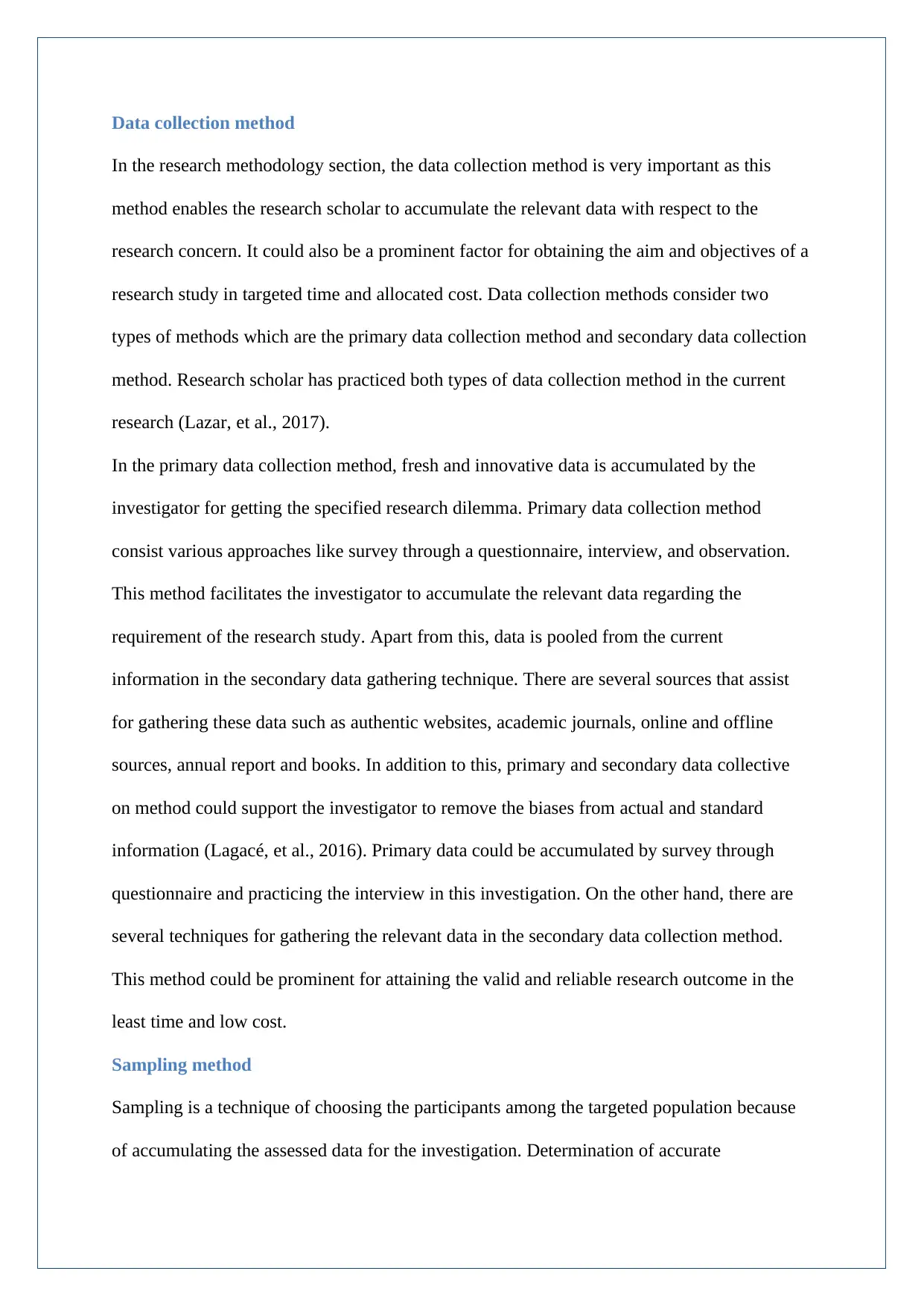
Data collection method
In the research methodology section, the data collection method is very important as this
method enables the research scholar to accumulate the relevant data with respect to the
research concern. It could also be a prominent factor for obtaining the aim and objectives of a
research study in targeted time and allocated cost. Data collection methods consider two
types of methods which are the primary data collection method and secondary data collection
method. Research scholar has practiced both types of data collection method in the current
research (Lazar, et al., 2017).
In the primary data collection method, fresh and innovative data is accumulated by the
investigator for getting the specified research dilemma. Primary data collection method
consist various approaches like survey through a questionnaire, interview, and observation.
This method facilitates the investigator to accumulate the relevant data regarding the
requirement of the research study. Apart from this, data is pooled from the current
information in the secondary data gathering technique. There are several sources that assist
for gathering these data such as authentic websites, academic journals, online and offline
sources, annual report and books. In addition to this, primary and secondary data collective
on method could support the investigator to remove the biases from actual and standard
information (Lagacé, et al., 2016). Primary data could be accumulated by survey through
questionnaire and practicing the interview in this investigation. On the other hand, there are
several techniques for gathering the relevant data in the secondary data collection method.
This method could be prominent for attaining the valid and reliable research outcome in the
least time and low cost.
Sampling method
Sampling is a technique of choosing the participants among the targeted population because
of accumulating the assessed data for the investigation. Determination of accurate
In the research methodology section, the data collection method is very important as this
method enables the research scholar to accumulate the relevant data with respect to the
research concern. It could also be a prominent factor for obtaining the aim and objectives of a
research study in targeted time and allocated cost. Data collection methods consider two
types of methods which are the primary data collection method and secondary data collection
method. Research scholar has practiced both types of data collection method in the current
research (Lazar, et al., 2017).
In the primary data collection method, fresh and innovative data is accumulated by the
investigator for getting the specified research dilemma. Primary data collection method
consist various approaches like survey through a questionnaire, interview, and observation.
This method facilitates the investigator to accumulate the relevant data regarding the
requirement of the research study. Apart from this, data is pooled from the current
information in the secondary data gathering technique. There are several sources that assist
for gathering these data such as authentic websites, academic journals, online and offline
sources, annual report and books. In addition to this, primary and secondary data collective
on method could support the investigator to remove the biases from actual and standard
information (Lagacé, et al., 2016). Primary data could be accumulated by survey through
questionnaire and practicing the interview in this investigation. On the other hand, there are
several techniques for gathering the relevant data in the secondary data collection method.
This method could be prominent for attaining the valid and reliable research outcome in the
least time and low cost.
Sampling method
Sampling is a technique of choosing the participants among the targeted population because
of accumulating the assessed data for the investigation. Determination of accurate
Paraphrase This Document
Need a fresh take? Get an instant paraphrase of this document with our AI Paraphraser
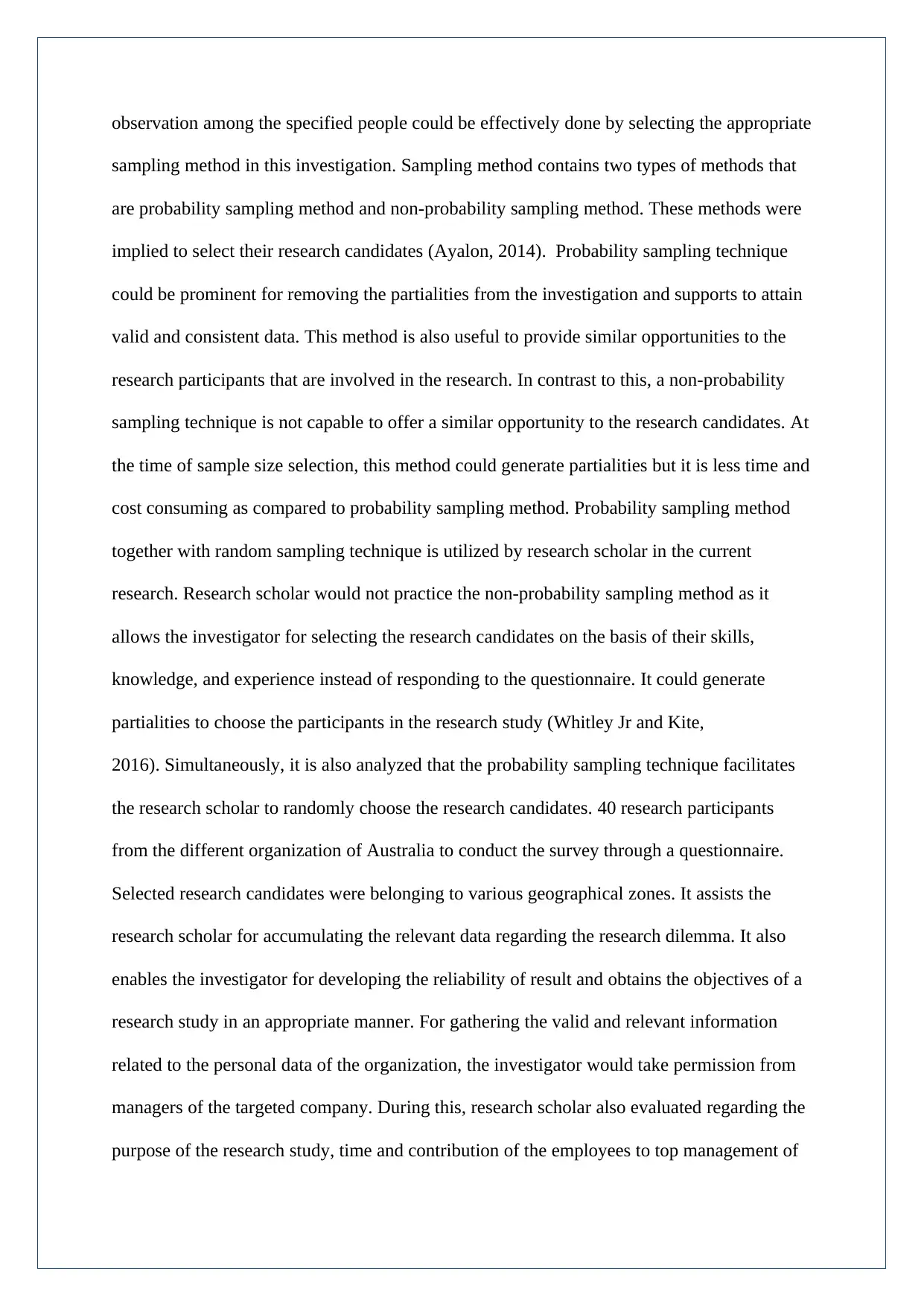
observation among the specified people could be effectively done by selecting the appropriate
sampling method in this investigation. Sampling method contains two types of methods that
are probability sampling method and non-probability sampling method. These methods were
implied to select their research candidates (Ayalon, 2014). Probability sampling technique
could be prominent for removing the partialities from the investigation and supports to attain
valid and consistent data. This method is also useful to provide similar opportunities to the
research participants that are involved in the research. In contrast to this, a non-probability
sampling technique is not capable to offer a similar opportunity to the research candidates. At
the time of sample size selection, this method could generate partialities but it is less time and
cost consuming as compared to probability sampling method. Probability sampling method
together with random sampling technique is utilized by research scholar in the current
research. Research scholar would not practice the non-probability sampling method as it
allows the investigator for selecting the research candidates on the basis of their skills,
knowledge, and experience instead of responding to the questionnaire. It could generate
partialities to choose the participants in the research study (Whitley Jr and Kite,
2016). Simultaneously, it is also analyzed that the probability sampling technique facilitates
the research scholar to randomly choose the research candidates. 40 research participants
from the different organization of Australia to conduct the survey through a questionnaire.
Selected research candidates were belonging to various geographical zones. It assists the
research scholar for accumulating the relevant data regarding the research dilemma. It also
enables the investigator for developing the reliability of result and obtains the objectives of a
research study in an appropriate manner. For gathering the valid and relevant information
related to the personal data of the organization, the investigator would take permission from
managers of the targeted company. During this, research scholar also evaluated regarding the
purpose of the research study, time and contribution of the employees to top management of
sampling method in this investigation. Sampling method contains two types of methods that
are probability sampling method and non-probability sampling method. These methods were
implied to select their research candidates (Ayalon, 2014). Probability sampling technique
could be prominent for removing the partialities from the investigation and supports to attain
valid and consistent data. This method is also useful to provide similar opportunities to the
research participants that are involved in the research. In contrast to this, a non-probability
sampling technique is not capable to offer a similar opportunity to the research candidates. At
the time of sample size selection, this method could generate partialities but it is less time and
cost consuming as compared to probability sampling method. Probability sampling method
together with random sampling technique is utilized by research scholar in the current
research. Research scholar would not practice the non-probability sampling method as it
allows the investigator for selecting the research candidates on the basis of their skills,
knowledge, and experience instead of responding to the questionnaire. It could generate
partialities to choose the participants in the research study (Whitley Jr and Kite,
2016). Simultaneously, it is also analyzed that the probability sampling technique facilitates
the research scholar to randomly choose the research candidates. 40 research participants
from the different organization of Australia to conduct the survey through a questionnaire.
Selected research candidates were belonging to various geographical zones. It assists the
research scholar for accumulating the relevant data regarding the research dilemma. It also
enables the investigator for developing the reliability of result and obtains the objectives of a
research study in an appropriate manner. For gathering the valid and relevant information
related to the personal data of the organization, the investigator would take permission from
managers of the targeted company. During this, research scholar also evaluated regarding the
purpose of the research study, time and contribution of the employees to top management of
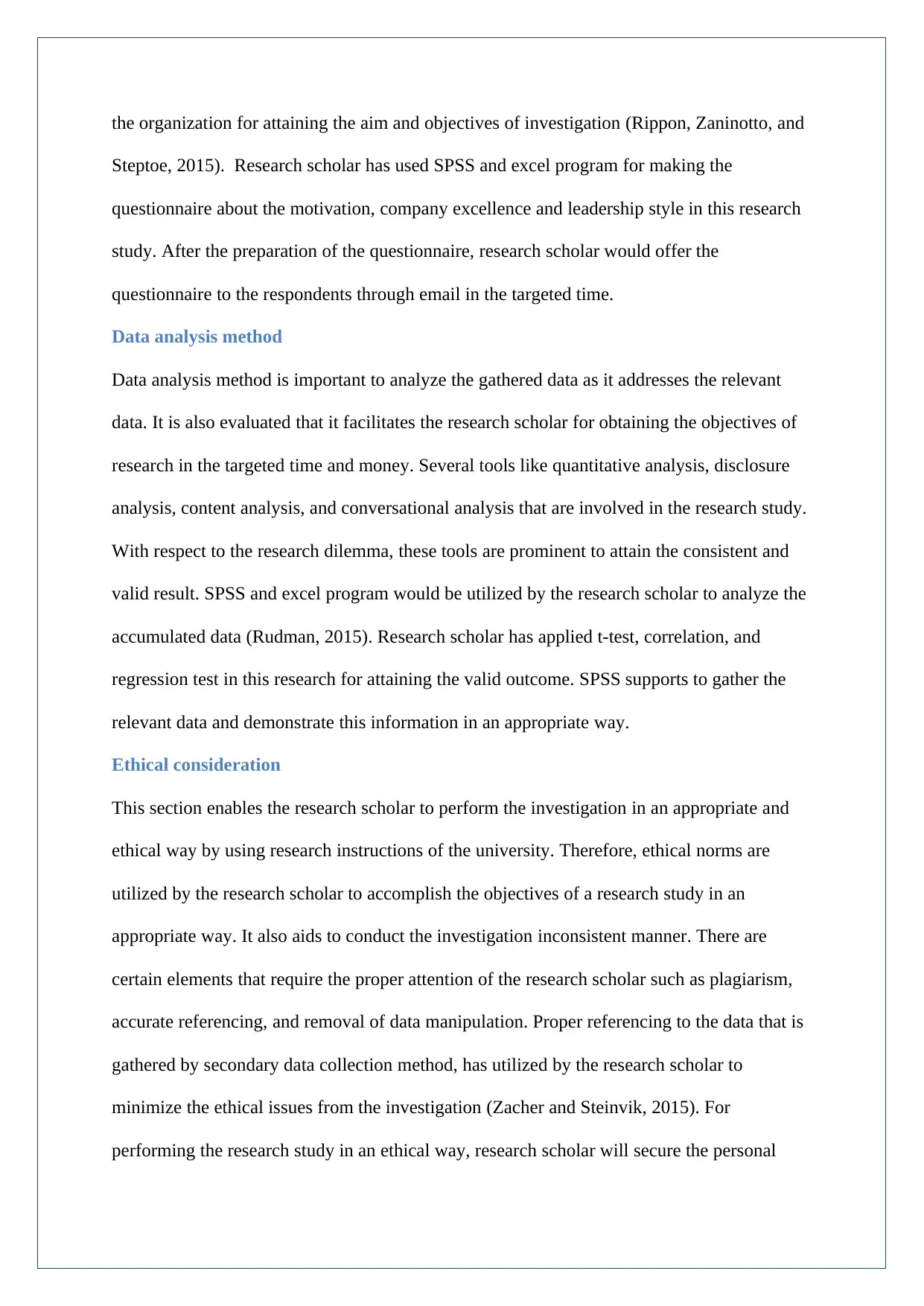
the organization for attaining the aim and objectives of investigation (Rippon, Zaninotto, and
Steptoe, 2015). Research scholar has used SPSS and excel program for making the
questionnaire about the motivation, company excellence and leadership style in this research
study. After the preparation of the questionnaire, research scholar would offer the
questionnaire to the respondents through email in the targeted time.
Data analysis method
Data analysis method is important to analyze the gathered data as it addresses the relevant
data. It is also evaluated that it facilitates the research scholar for obtaining the objectives of
research in the targeted time and money. Several tools like quantitative analysis, disclosure
analysis, content analysis, and conversational analysis that are involved in the research study.
With respect to the research dilemma, these tools are prominent to attain the consistent and
valid result. SPSS and excel program would be utilized by the research scholar to analyze the
accumulated data (Rudman, 2015). Research scholar has applied t-test, correlation, and
regression test in this research for attaining the valid outcome. SPSS supports to gather the
relevant data and demonstrate this information in an appropriate way.
Ethical consideration
This section enables the research scholar to perform the investigation in an appropriate and
ethical way by using research instructions of the university. Therefore, ethical norms are
utilized by the research scholar to accomplish the objectives of a research study in an
appropriate way. It also aids to conduct the investigation inconsistent manner. There are
certain elements that require the proper attention of the research scholar such as plagiarism,
accurate referencing, and removal of data manipulation. Proper referencing to the data that is
gathered by secondary data collection method, has utilized by the research scholar to
minimize the ethical issues from the investigation (Zacher and Steinvik, 2015). For
performing the research study in an ethical way, research scholar will secure the personal
Steptoe, 2015). Research scholar has used SPSS and excel program for making the
questionnaire about the motivation, company excellence and leadership style in this research
study. After the preparation of the questionnaire, research scholar would offer the
questionnaire to the respondents through email in the targeted time.
Data analysis method
Data analysis method is important to analyze the gathered data as it addresses the relevant
data. It is also evaluated that it facilitates the research scholar for obtaining the objectives of
research in the targeted time and money. Several tools like quantitative analysis, disclosure
analysis, content analysis, and conversational analysis that are involved in the research study.
With respect to the research dilemma, these tools are prominent to attain the consistent and
valid result. SPSS and excel program would be utilized by the research scholar to analyze the
accumulated data (Rudman, 2015). Research scholar has applied t-test, correlation, and
regression test in this research for attaining the valid outcome. SPSS supports to gather the
relevant data and demonstrate this information in an appropriate way.
Ethical consideration
This section enables the research scholar to perform the investigation in an appropriate and
ethical way by using research instructions of the university. Therefore, ethical norms are
utilized by the research scholar to accomplish the objectives of a research study in an
appropriate way. It also aids to conduct the investigation inconsistent manner. There are
certain elements that require the proper attention of the research scholar such as plagiarism,
accurate referencing, and removal of data manipulation. Proper referencing to the data that is
gathered by secondary data collection method, has utilized by the research scholar to
minimize the ethical issues from the investigation (Zacher and Steinvik, 2015). For
performing the research study in an ethical way, research scholar will secure the personal
⊘ This is a preview!⊘
Do you want full access?
Subscribe today to unlock all pages.

Trusted by 1+ million students worldwide
1 out of 18
Related Documents
Your All-in-One AI-Powered Toolkit for Academic Success.
+13062052269
info@desklib.com
Available 24*7 on WhatsApp / Email
![[object Object]](/_next/static/media/star-bottom.7253800d.svg)
Unlock your academic potential
Copyright © 2020–2025 A2Z Services. All Rights Reserved. Developed and managed by ZUCOL.





